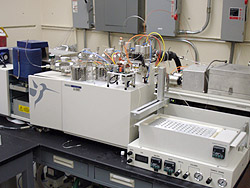The department of Geology hosts the UPRM Gas Analysis Stable Isotope Laboratory (GASI Lab), recently constructed through a grant from the National Science Foundation Major Research Instrumentation program and the University of Puerto Rico Central Administration. The GASI Lab’s main research tool is the IsoPrime Multiflow System, which is an automated system for water equilibration (on as little as 200ml), carbonated, DIC, and 13C labeling studies. Performance is optimized through the ability to analyze smaller sample sizes and to undertake multiple analyses from a single sample container, all under the extremely capable control of fully automated high throughput system.
GASI Lab: Room F-107
Stable Isotope Ratio Mass Spectrometry
WHAT WE DO :
measure the relative abundances (or the ratio) of the stable isotopes of C, O, and H. For example, carbon has two stable isotopes 12C and 13C, with approximate abundances of 98.89% and 1.11%, respectively. Small variations of these abundances occur in nature, which can be measured accurately and precisely.
HOW WE DO IT :
we measure the abundances (or concentrations) of these stable isotopes using a stable isotope ratio mass spectrometer, introducing our samples in a gaseous form (C or O as CO2 and H as H2). The gas molecules are converted to ions in a vacuum, and then accelerated by a high voltage through a magnetic field, which causes the ions to curve. The radius of the curve depends on the mass of the ion, and then detectors are positioned to measure the beam size corresponding to the different masses. This allows the relative abundances, or stable isotope ratios to be measured.
WHY WE DO IT :
measuring the stable isotope ratio of these elements can be a very useful technique, as it can provide an independent piece of information concerning the sample being measured. Specifically, there are 3 common applications:
1. Temperature – the isotope ratios in co-existing phases depends on temperature (the same as an equilibrium constant changing with temperature). This is commonly used to investigate historical climates preserved in ice cores, deep sea sediments, tree rings, etc.
2. Sources – compounds derived from different sources often have a different isotopic composition, which may allow us to identify where a particular compound is coming from. For example, the carbon isotopic composition of coal and oil is quite different from that of CO2 in air. Burning coal and oil adds CO2 to the air with a very different isotopic composition.
3. Processes – many physical, chemical, or biological processes cause small changes in isotopic composition during the reaction. Measuring the isotopic composition of a compound in space and time may help us identify a process that’s hard to do otherwise. For example, changes in isotopic composition during plant photosynthesis depend upon the type of photosynthesis.
In summary, stable isotope ratio mass spectrometry can be used for many types of research so it has many diverse applications in the earth, natural, life, and environmental science.
CONTACT:
Yelitsa I. González
GASI Lab Instrumentation Specialist
Physics Building F-106
Tel. (787) 832-4040 Ext. 3981
email: yelitsai.gonzalez@upr.edu
Instrumentation available:









